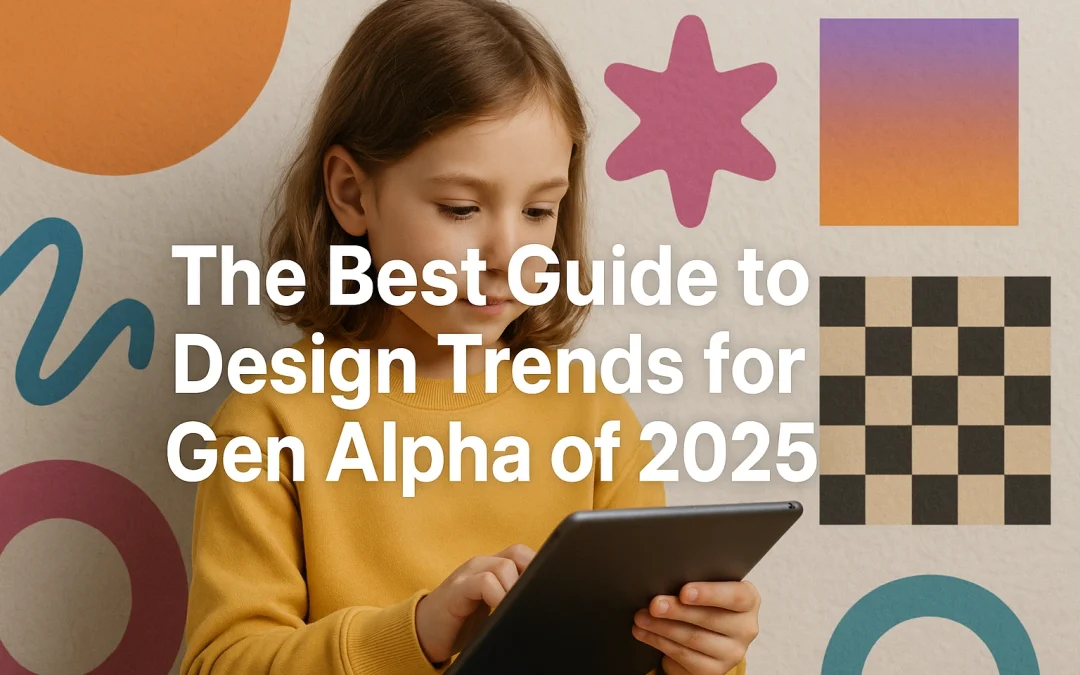Introduction: The Rising Influence of Gen Alpha on Global Design Trends
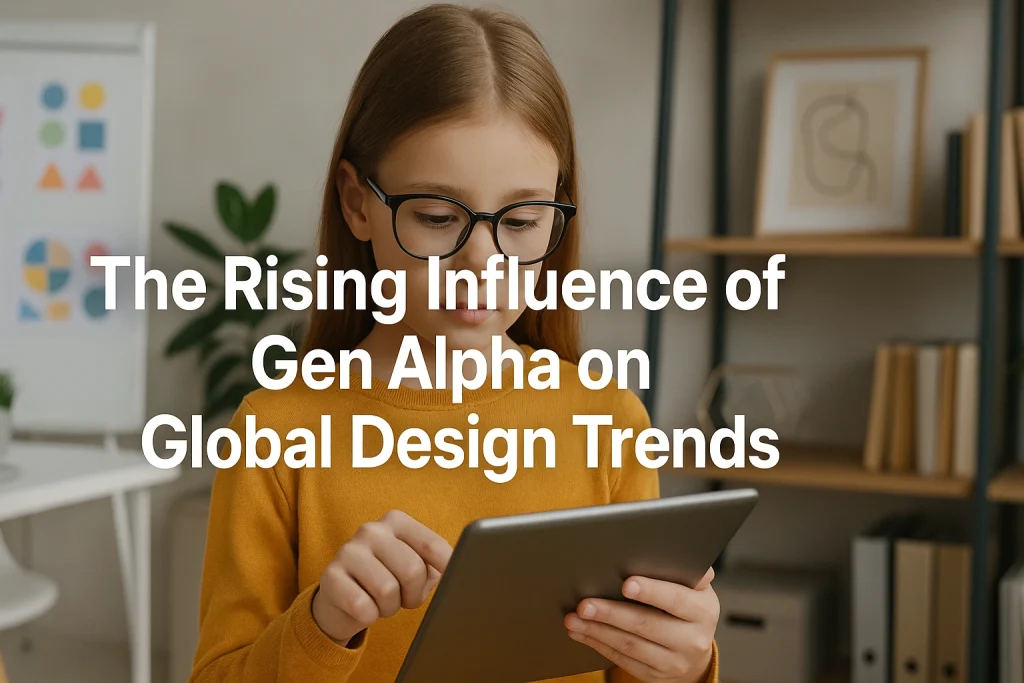
The world of design is evolving at an unprecedented pace, and one generation is at the center of this transformation—Generation Alpha. Born between 2010 and 2025, these children of Millennials are the first fully digital-native generation, growing up surrounded by AI-powered devices, immersive technology, and a constant flow of visual stimuli. For designers, brands, and creators, understanding design trends for gen alpha is no longer optional—it’s the blueprint for the future.
Generation Alpha interacts with design in ways no previous generation has. Every element of their environment—from the color palettes of their playrooms to the interfaces of their favorite learning apps—is part of a connected ecosystem. They expect seamless transitions between the physical and digital worlds, where creativity, interactivity, and personalization are not luxuries but default expectations. This shift challenges designers to move beyond aesthetics and focus on experiential, inclusive, and intelligent design.
Globally, Gen Alpha is projected to become the largest and most influential consumer group in history, with a combined economic impact surpassing even Gen Z and Millennials. Their preferences are already shaping how industries think about products, branding, and storytelling. Reports from Camphouse and WGSN highlight that Gen Alpha’s influence extends across multiple sectors—from interior and product design to digital UX and visual communication—driven by values of diversity, sustainability, and digital immersion.
To connect with this emerging audience, designers must anticipate how Gen Alpha’s lifestyles and behaviors translate into design expectations. This means building future-ready spaces, products, and interfaces that reflect their curiosity, creativity, and technological fluency.
This guide explores the core principles defining design trends for gen alpha, from interior aesthetics and digital experiences to brand storytelling and visual communication. You’ll discover how this generation’s mindset is redefining creativity, and how adopting these design trends for gen alpha today can help brands, educators, and innovators stay ahead in a rapidly shifting visual and cultural landscape.
2. Who is Generation Alpha? Birth years, values & behaviours

First, let’s set the scene. Generation Alpha—often called Gen Alpha—comprises the children born after Generation Z. Most sources place their birth years roughly between 2010 and 2025.
These are children whose entire lives are unfolding in the 21st century. Never have they known a world without smartphones, tablets, voice assistants or streaming platforms. They are truly digital natives—and that changes everything about how they perceive design trends for gen alpha.
2.1.Key facts about Gen Alpha:
-
They are growing up in globally connected, culturally diverse contexts, with parents largely from the Millennial generation.
-
Their spending power direct and via parents will be enormous. Forecasts suggest this generation will shape markets and culture by the 2030s.
-
Their attitudes toward design, tech and consumption reflect priorities such as inclusivity, sustainability, seamless digital interfaces, and interactive experiences.
Understanding design trends for gen alpha is the first step; designing for them is the next. The remainder of this article will dive into design trend clusters across three major domains—and then translate these into actionable tips for brands and creators.
3. Core Characteristics of Gen Alpha That Drive Design

Before diving into specific trends, it’s valuable to understand the underlying characteristics of Gen Alpha that shape their design preferences:
3.1 Digital-native mindset
From early childhood, design trends for gen alpha interacts with screens, apps and connected devices. They expect interfaces to be frictionless. According to UX research, Gen Alpha:
-
Expects instant load times, seamless transitions and mobile-first experiences.
-
Are comfortable with multi-platform, voice and gesture controls.
-
Learn through play and interactivity — gamified, tactile experiences are more engaging than passive ones.
3.2 Socially conscious & inclusive values
While still young, Gen Alpha is growing up in a world where diversity, sustainability and authenticity are front of mind.
-
Their preferences reflect inclusive representation in media and design trends for design trends for gen alpha.
-
They are often influenced by parent values Millennials who prioritise ethical brands, environmental responsibility and early childhood development.
-
For designers, this means avoiding token gestures and instead embedding true diversity of representation, materials and experience design trends for gen alpha.
3.3 Material comfort and early brand exposure
design trends for gen alpha is often described as the most materially endowed generation ever via parent investment and also one exposed to brands, digital experiences and consumption earlier than any prior generation.
This means design trends for gen alpha must elevate: effortless, fun, premium—but approachable. Design trends must balance playfulness with durability and brand authenticity.
4.Design Trend Cluster 1: Physical Spaces & Interiors for Gen Alpha
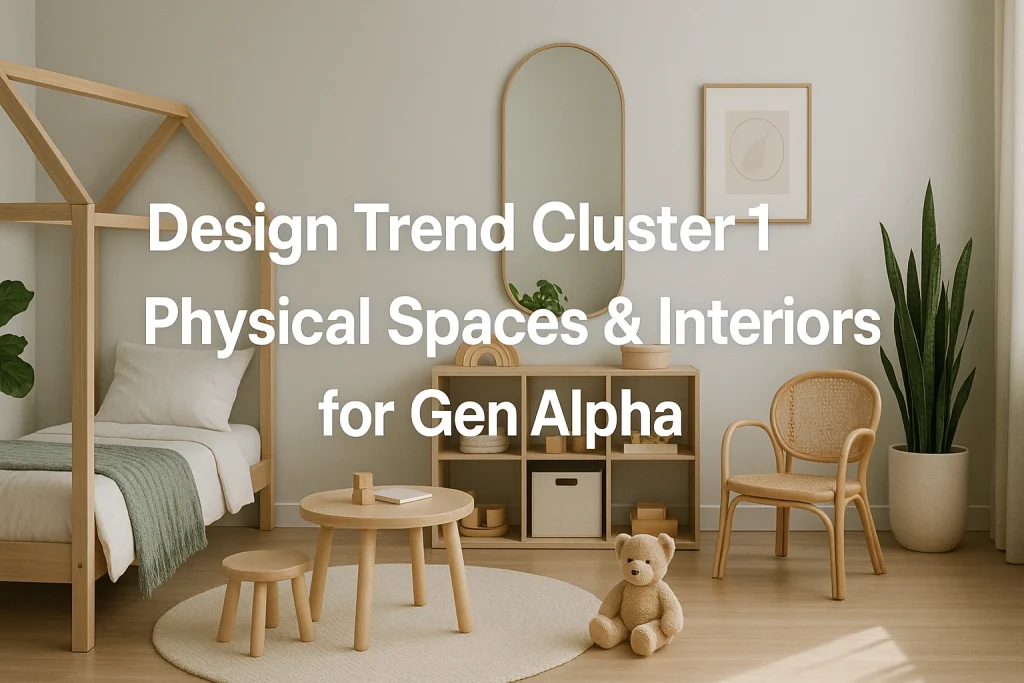
design trends for gen alpha environments for Gen Alpha—whether bedrooms, playrooms, or public youth spaces—requires a fresh lens. Here are the major trends emerging.
4.1 Colour palettes & materials
-
Pastel tones, but with a twist: while children’s spaces historically leaned bright primary colours, Gen Alpha spaces often favour more muted pastels or sophisticated pops of colour—mixing fun with calm.
-
Natural materials and sustainability: recycled plastics, bamboo, low-VOC materials, and furniture designed to grow with the child (adjustable height, modular).
-
Modular forms and flexible furniture: Spaces are multi-purpose — study/play/relax. Designs reflect adaptability: fold-away desks, convertible shelves, lounge-friendly seating.
-
Playful textures and tactile surfaces: kids in this generation expect tactile interaction—soft-touch surfaces, interactive wall panels, built-in tech.
These trends respond to their demand for both play and functionality.
4.2 Furniture and modular forms
-
Expandable furniture: desks that grow, chairs that adjust, storage systems that adapt.
-
Social spaces: with screen use, remote learning and shared experiences, children’s rooms are becoming social hubs—not just sleeping pods. Designers are integrating hang-out zones, comfortable seating, tech hubs.
-
Statement pieces with character: Rather than purely generic kids furniture, we’re seeing furniture with personality—bold shapes, fun ergonomics, expressive colours that reflect Gen Alpha’s aesthetic.
4.3 Playful vs minimalist aesthetics
Interestingly, the interior design trends for gen alpha world suggests Gen Alpha favours both playful and minimalist aesthetics depending on context. In one research piece, younger design trends for gen alpha members preferred chill, simple, relaxing spaces when it comes to design of youth environments.
-
Playful aesthetic: vibrant accent walls, interactive zones, built-in gaming or VR corners, wall murals, fun furniture.
-
Minimalist aesthetic with purpose: clean lines, decluttered spaces, multifunction furniture, soothing colour palette.
Designers aiming for design trends for gen alpha must balance these: enabling fun, tech and play, while also providing calm, restful spaces.
5. Design Trend Cluster 2: Digital Products & UX for Gen Alpha

Given Gen Alpha’s digital upbringing, designing product experiences apps, websites, interactive experiences with their mindset is critical.
5.1 Mobile-first & multi-platform
When designing for design trends for gen alpha in the UX domain:
-
Start with mobile: Devices are primary for this generation. But apps must also translate to tablets, screens, voice devices, AR/VR.
-
Consistent cross-platform experience: If a child starts on a tablet, they may continue on a large screen, or switch to a voice device. The experience must feel seamless.
-
Performance and load speed matter: Long load times or clunky UX kill engagement quickly. Gen Alpha has little patience for friction.
5.2 Voice, gesture & AR/VR interfaces
-
Voice assistants, gesture controls, AR overlays—these are no longer “nice to have” but expected forms of interaction for Gen Alpha.
-
Examples: An educational game that responds to voice commands; an AR app in a kids museum that lets them ‘paint’ walls with gestures; a mobile shopping app for kids that uses voice prompts.
-
Designers must anticipate multi-sensory interaction, not just tap/swipe.
5.3 Gamification and interactive experiences
-
Learning through play: Gen Alpha expects interactivity. Educational apps or digital products must engage, not just present. Badges, leaderboards, progress visuals: these elements resonate—but should be integrated thoughtfully with design, not forced.
-
Personalisation and co-creation: Products that let Gen Alpha personalise avatars, design their own characters, create content, will have higher resonance.
-
UX and UI must feel light, fun, friendly—but also polished: the bar is high because they’re used to high-quality design trends for gen alpha experiences.
6. Design Trend Cluster 3: Visual & Graphic Design Aesthetics for Gen Alpha
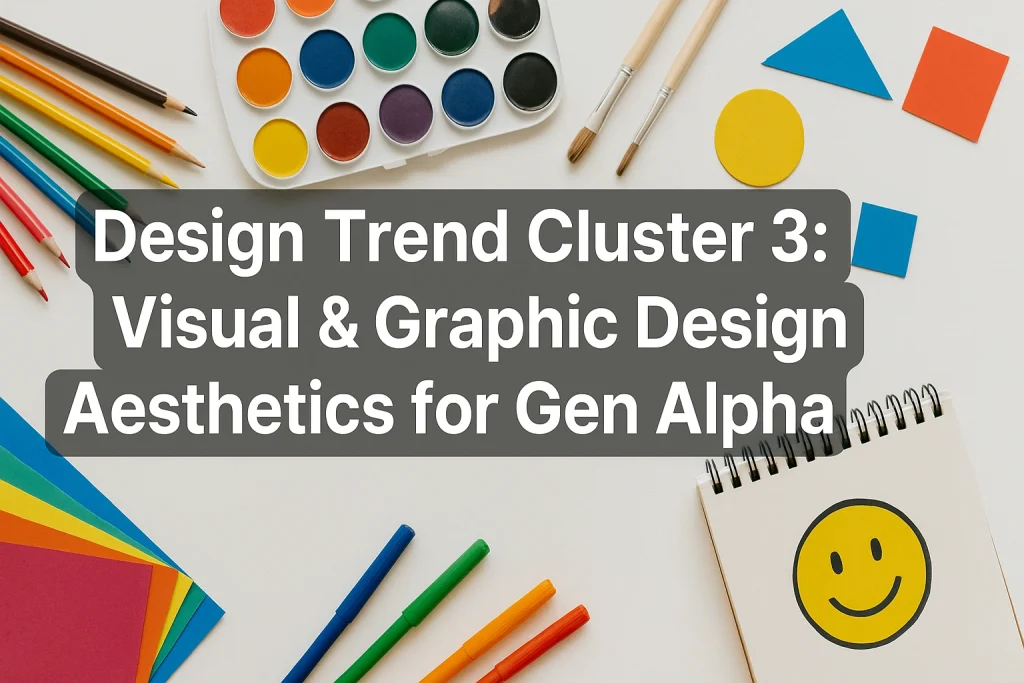
Visual style has a huge role in capturing Gen Alpha’s attention—whether in physical decor, digital products or branding.
6.1 Illustration styles, iconography, typography
-
Bold, playful yet clean illustration: Think friendly characters, inclusive representation, dynamic layouts.
-
Typography: rounded, friendly fonts; variable weights; readable for younger users but with youthful personality.
-
Icons and micro-interactions: Visual cues that respond to children’s actions help create delight and intuitiveness.
6.2 Youth-centric aesthetics and micro-generations
-
Trend sub-aesthetics e.g., coquette, cottage core are influencing teen and tween styles—design trends for gen alpha should monitor how Gen Alpha adopts or adapts these visual languages.
-
Colour trends for Gen Alpha visuals may favour softer pastels mixed with energetic accents, as well as gender-neutral palettes.
-
Nostalgia‐inspired yet forward-looking: Since Gen Alpha are digital natives, retro references may matter less—but futuristic playful visuals resonate e.g., soft chrome, holographic finishes, fluid shapes.
6.3 Inclusive and diverse visuals
-
Representation in visuals skins, games, furniture, spaces must reflect diversity of Gen Alpha’s world.
-
Design languages should feel age-appropriate, authentic and avoid tokenism: brands/designers that authentically integrate inclusive visual design will perform better.
6.4 Brand & Marketing Implications: Designing for Gen Alpha
What do these design trends mean for brands, designers and strategists? Here’s how to translate insights into action.
6.5 Aligning brand values with Gen Alpha expectations
-
Gen Alpha values authenticity, diversity, sustainability. Brands must reflect this in design: materials that are eco-friendly, visuals that show real children in inclusive settings, digital products that respect privacy and user control.
-
Early exposure: With Gen Alpha’s parents investing heavily in early childhood, brands that design with children (and parents) in mind now will gain long-term loyalty.
6.6 Trend forecasting: What’s next beyond 2025
-
Expect increasing immersive experiences: AR/VR in both physical spaces and digital products will proliferate for Gen Alpha.
-
Biophilic design + digital integration: Spaces that combine natural materials, plants, and tech e.g., smart light that adjusts to mood, interactive wall panels.
-
Hybrid play-study-relax spaces: Especially as remote/hybrid schooling becomes common, Gen Alpha’s rooms and digital products will reflect multifunction usage.
6.7 Practical tips for designers, product teams and brands
-
Conduct co-creation workshops: Ask Gen Alpha kids and families for feedback on design prototypes.
-
Use prototyping tools that allow rapid iteration for younger audiences: test interfaces for speed, fun factor, understandability.
-
Prioritise performance: For digital products, keep load times low, animations smooth, interactions intuitive.
-
For interiors, choose durable, modular furniture; acoustic control kids mix play + study + relax.
-
For visuals, ensure accessible typography and colours, friendly iconography, and inclusive representation.
7.How to Implement These Design Trends: A Step-by-Step Checklist

Here is a practical checklist to help you adopt the design trends for Gen Alpha:
- Define your target sub-segment: Are you designing for early Gen Alpha (ages 5-10) or older (10-15)? Their needs differ.
- Audit current design assets: Evaluate your existing spaces, product UX, visuals—how well do they align with Gen Alpha behaviour and preferences?
- Map behaviour → design implications: Use the characteristics above to map how Gen Alpha uses devices, spaces, consumes media, interacts with visuals.
- Select trend clusters to focus on: Choose if your priority is interior/physical spaces, digital products, or branding/visual design (or a mix).
- Create prototypes: For interiors – mood boards, furniture modules; For digital – UX wireframes, micro-interaction tests; For visuals – illustration sets, iconography.
- Test-with real users: If possible, involve Gen Alpha children or their parents in testing. Observe how they engage, what they resist.
- ** optimise for inclusivity & sustainability**: Ensure materials, visuals, interactions reflect inclusive and eco-friendly values.
- Iterate and refine: Collect feedback and data, refine until the experience feels seamless for Gen Alpha.
- Launch and monitor: After launch, monitor engagement (dwell time, interaction rate, bounce) and solicit feedback.
- Future-proof: Build in flexibility — modular furniture, updateable UX, adaptive visuals — because Gen Alpha’s preferences will continue evolving rapidly.
8. Challenges & Pitfalls to Avoid When Designing for Gen Alpha

Designing for Gen Alpha is exciting — but there are pitfalls:
-
Assuming just add bright colours: Simplistic design tweaks won’t suffice. Gen Alpha expects polished, intuitive, relevant design.
-
Forgetting performance: In digital products, slow load times or laggy interactions will disengage younger users quickly.
-
Token inclusion: Simply adding diverse visuals isn’t enough — authenticity and context matter.
-
Over-specialising too early: Given the age range (2010-2025), their tastes and behaviours will vary widely. Design flexibility into your solution.
-
Ignoring parent influences: While you’re designing for Gen Alpha, their parents (Millennials) often drive purchase decisions or access. Design must appeal to both.
-
Neglecting sustainability and ethics: Gen Alpha is growing up with awareness of climate issues; design that ignores sustainability may clash with their values.
-
Failing to anticipate rapid change: This generation grows fast; the design you launch now might feel outdated in three years unless future-proofed.
9. Conclusion: The Future of Design Is Being Shaped by Gen Alpha
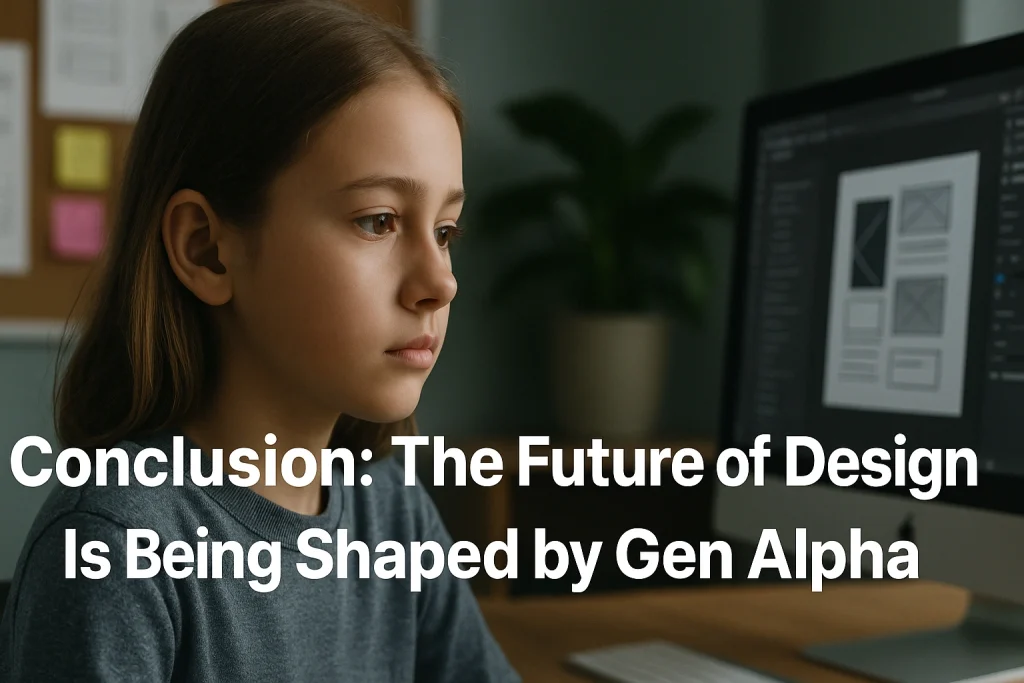
As we stand at the crossroads of creativity and technology, design trends for Gen Alpha represent far more than fleeting aesthetic shifts—they mark the dawn of an entirely new design era. Generation Alpha is redefining how humans interact with spaces, brands, and digital experiences. Their influence extends across every design discipline—from interiors and fashion to UX/UI, branding, education, and product innovation.
Unlike previous generations, Gen Alpha has never known a world without smart devices, streaming, and on-demand personalization. Their design expectations are inherently interactive, intuitive, inclusive, and intelligent. They crave experiences that blend play with purpose, colour with consciousness, and technology with emotion. This makes them not just a consumer audience, but a co-creator generation—one that participates, personalizes, and redefines the creative process.
For designers and brands, this presents both an opportunity and a challenge. To truly connect with Gen Alpha, design must evolve around five enduring principles:
- Interactivity: Design should invite participation through touch, voice, gesture, and AR/VR experiences.
- Inclusivity: Visual and experiential design must celebrate diversity in age, gender, culture, and ability.
- Sustainability: From materials to manufacturing, ethical and eco-conscious choices will be expected, not optional.
- Seamlessness: The boundaries between digital and physical must dissolve—design should feel unified across every medium.
- Emotional Intelligence: Beyond function and form, Gen Alpha values authenticity, creativity, and emotional connection.
As their cultural and economic influence grows, Gen Alpha will guide the next two decades of global design. By adopting these trends today, brands, educators, and innovators can build meaningful connections that endure into the 2030s and beyond. Those who act early—experimenting with inclusive aesthetics, immersive UX, and adaptive spaces—will not only remain relevant but lead the creative evolution shaping our collective future.
Design for Gen Alpha isn’t just about anticipating what comes next—it’s about designing the future itself.
10. References & Further Reading

-
Gen Alpha Trends 2025: Shaping the Future – Camp House blog. Camphouse
-
Designing for Gen Z and Alpha: 5 Insights from the Next Generation of Innovators – WorkDesign.
-
Designing for Gen Alpha – Crafting Experiences for Digital Natives – Nicole Steffen.
-
Generation Alpha Trends: A Strategic Blueprint for the Future– Lindsay Angelo.
-
Keyword difficulty & research best practices: Keyword Difficulty Explained: 2025 Guide & Best Practices – Search Atlas.
-
Inclusive and interactivity design for Gen Alpha – Collage Group white paper.

